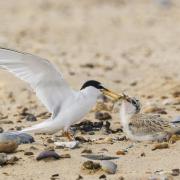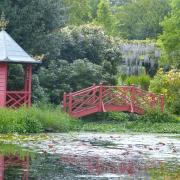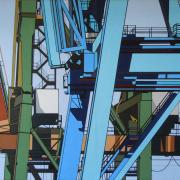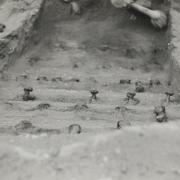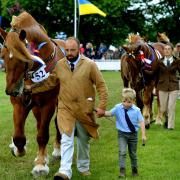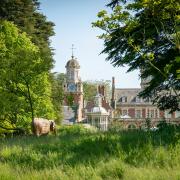Artist Julian Perry finds beauty and romance in a world under siege from environmental destruction.
Slabs of tarmac roads and broken brick walls lying on a beach, trees gnarled and pollarded in empty fields. Studies of leaves diseased and yellowing, caravans and bungalows falling off cliffs or hovering above the ground. Scenes of catastrophe or destruction are hauntingly beautiful and thought-provoking in the intense, unsettling, intricate paintings of Julian Perry.
“Falling off cliffs is a fairly good metaphor for the state of the world’s environment,” says Julian, who has become known for his comment on climate change through his work. “But I have never wanted to appear angry. I am not a polemical artist. I want to use beauty so that people are taken aback.” His pictures are indeed breathtaking. At White House Farm, Glemham, in east Suffolk, his current exhibition, The Pollard Residency, presents rich, vast oil paintings of deformed and contorted tree trunks and stunted branches, alongside small sepia studies of ancient oaks.

All these trees are relics and reminders of a time when the air was cleaner and the natural world was abundant. Pollarding - harvesting firewood and timber from trees without felling them - is no longer commonly practised and there’s a worry that we may lose many of our ancient trees as a result. It points to a time when man worked in rhythm with nature. "A tree’s natural life is 200 to 300 years, but pollarding means they can last even millennia,” Julian says. “Trees have been shaped by human activity over hundreds of years and my paintings celebrate the deformities of being lopped.”
He was asked to study the trees at Glemham by Jason Gathorne-Hardy, owner of the farm and founder of Galloper-Sands, the online gallery of the Alde Valley Festival which runs events and year-round residencies for contemporary artists and craft makers. “I’d never been there before,” says Julian, “and it was very rustic, with chickens walking past outside. I was used to galleries with air conditioning, wire barriers and CCTV cameras everywhere. But it’s worked out really well for me here. I’ve met so many interesting people.”
Julian spent a year of the Covid lockdowns sitting beneath Glemham's venerable trees, painting in the fields. As with all his subjects, he draws on Constable, Turner, Duhrer and Rubens in style, influence and imagery. Some of his pictures feature as trompe l’oeil, altarpieces and triptychs, using religious symbolism and wartime motifs to challenge us to think about our relationship with the landscape today.

“A good picture makes people think about all sorts of things,” says Julian. “I provoke conversations wherever my work is exhibited.” Coastal erosion, rising sea levels, urban decay and man’s relationship with nature have all been explored in his work which attracts widespread acclaim and attention. He has won British Council and Arts Council England awards, and lectured for the Royal Drawing School. “In the lecture it became a bit of a joke because everything in the landscape that I painted seemed to have been destroyed or swept away by a tidal surge - the tree was cut down, something had been demolished or a motorway had gone through,” he says. “But I think an artist has to be inspired and I am, by environmental issues.”
Julian was introduced to painting as a child by his grandfather, a theatre set painter, and went on to study at Bristol before moving to London, where he resolved to be a landscape artist. “The area of east London where I lived was a pretty depressed area,” he says. “I didn’t want to paint the supermarket trolleys in the river. I tried to look for more romantic subjects. I was exploring the idea that a place is what you make it and if I could have a positive, romantic attitude to the area, then that was good for me.”
He chose scenes which weren’t typically the subjects for paintings – tower blocks, tube trains in moonlight, mangled goal posts and muddy, abandoned football pitches. There were allotments about to be bulldozed to make way for the Olympic Park and a wartime crater transformed into an overgrown pond in Epping Forest. His work was well received and he gained numerous commissions with individuals and institutions who delighted in his different perspective of London life. Then a bereavement caused Julian to take a new route with his work.

“My mother died and I entered another phase in my life,” he says. Contemplating her loss, he longed to hear nightingales singing at Waltham Abbey, next to the M25, and this led him back to his childhood love of nature reserves. Little by little, his work led him further away from the city and closer to the sea, although he continued to seek beauty in unappreciated locations. When he chose to paint the construction of Sizewell B nuclear power station, Julian rediscovered Dunwich which he remembered visiting as a child.
“When I was eight my parents brought me birdwatching here and it made a very big impression,” he says. “Coming back I had a sense that this is where I belong.” The village is sometimes labelled ‘the capital of coastal erosion’; Dunwich was once a mile inland, and has lost houses, churches and communities to the sea. Julian started work on pictures representing the enormity of climate change in this area. “One of the defining characteristics of landscape is change,” he says. “The ultimate expression of that is coastal erosion where our landscape is literally disappearing, dissolving and being swept away.”
His last exhibition focused on this subject, depicting scenes along the east coast, in a solo show at Southampton City Art Gallery presenting 70 pictures throughout five rooms. Called There Rolls The Deep, after a Tennyson poem, it was accompanied by choral music and included a graph on the wall highlighting the increasing rate of carbon dioxide in the atmosphere, from Albrecht Duhrer in 1530 to Julian Perry today. The exhibition featured a secular altarpiece and 14 Stations of the Cross – perspex boxes with a painting of a scene before and after erosion, displayed using a mirror.

Julian's work is innovative and original, and is now very much infused and inspired by his life in Suffolk. From his terraced cottage in Dunwich, he delights in views of the marsh, forest, heath, beach and coastline. “I love the sheer specialness of being here,” he says. “We’ve watched porpoises, marsh harriers, Dartford warblers, and in the evenings the red deer come out from the forest and stand with the cattle. The nightingales sing in the woods and there are lots of owls. It’s like a vision of heaven, and it represents what I’m fighting for.”
Julian Perry’s paintings can be viewed throughout 2023 at The Pollard Residency galloper-sands.co.uk
julianperry.info
















